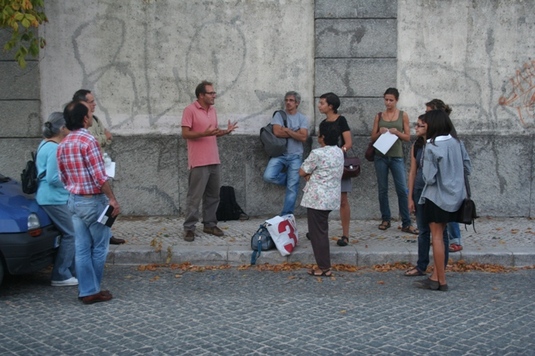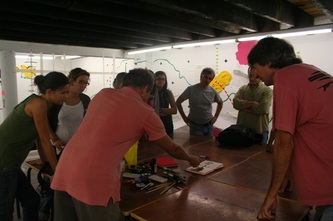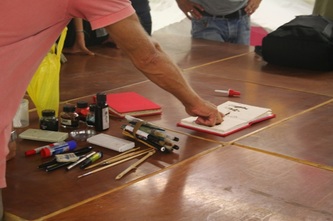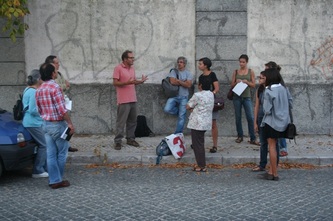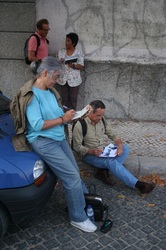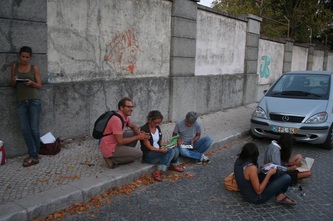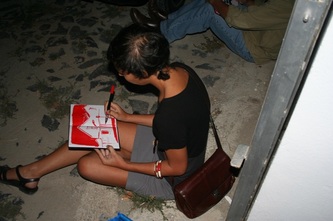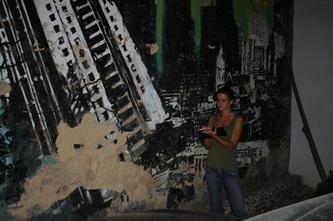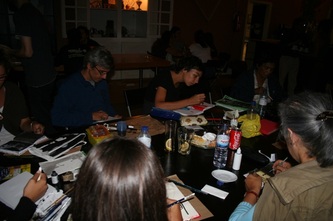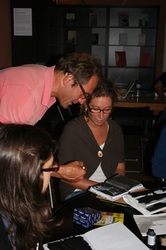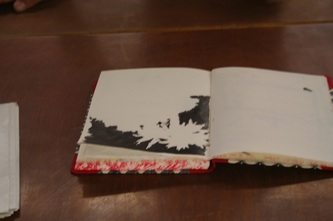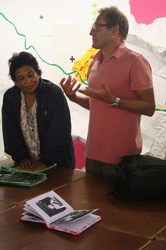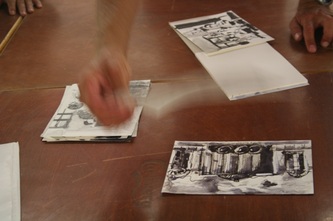_© All rigths reserved to Associação Espaços do
Desenho-Drawing Spaces. Text.Sound.Video.Images
_
URBAN CIRCUIT
WORKSHOP Developed as PART OF A SERIES OF WORKSHOPS
UNDER THE THEME “8 POSSIBILITIES OF MAKING DRAWING"
Drawing Spaces, Lisbon, Portugal
16 SEPTEMBER 2011
.
WORKSHOP Developed as PART OF A SERIES OF WORKSHOPS
UNDER THE THEME “8 POSSIBILITIES OF MAKING DRAWING"
Drawing Spaces, Lisbon, Portugal
16 SEPTEMBER 2011
.
REPORT 9 -
IDEAL
Intercultural Drawing for European Adult Learning
Intercultural Drawing for European Adult Learning
WHAT
This workshop aimed to stimulate the use of graphic diaries to produce experimental drawings using the graphic diary as a personal study tool. The aim was also to remove any expectation of producing final artistic drawings, but rather to provide oneself with the opportunity of experimenting different ways of making drawing and by turning the page, to be able to engage with a new or progressive stage of the study. The proposed drawing strategy was to follow a short urban circuit, outdoors, while registering in different manners the changes of light as evening arose.
WHERE
Drawing Spaces, Fábrica de Braço de Prata, Lisbon, Portugal.
WHEN
16 September 2011, 19h00-23h00
WHO
Facilitators and Staff
João Catarino
Eduardo Salavisa
Teresa Carneiro
ADULT LEARNERS
10 Female and Male adults, with an age range between 23 and 54 years old.
(This workshop was open to anyone)
WHY
This workshop was part of a project which aimed to respond to the dynamics of Drawing Spaces by presenting a series of public workshops coordinated by a variety of experts in the field of drawing. These workshops took place over a period of 2 weeks, during opening hours – from Wednesday to Saturday, from 19h to 23h – following the ‘open residency’ model. This gave the public the opportunity to daily visit and accompany the development of these experimental sessions around drawing.
These series of workshops were designed to extend the public contact with artists and with the specificity of the artist’s modes of working in their personal projects. The artists were asked to develop a workshop that maximized the interaction with the public; it was proposed to the public to participate in more than one of the workshops and to observe the diversity of the artists’ approaches. For this workshop, the proposed drawing strategy was to follow a short urban circuit, outdoors, while registering in different manners the changes of light as evening arose. In this way there was a drawing subject to focus upon in the studies – the observation of light (natural and artificial), and its changes in and with the environment – and several drawing strategies applied to this specific study.
HOW
This session was developed following a short urban circuit, outdoors, which aimed to follow and register in different manners the changes of light as evening arose. Participants were encouraged to draw with spots and different contrast drawing methods, as well to draw by usingblack on white and white on black. Several experiments were done also exploring bleach as a drawing medium.
After the urban circuit, different experiences were proposed inside the bar of Fábrica Braço de Prata, also with the aim of studying the light through drawing. From studies of natural light, to studies of artificial light this workshop encouraged also to study of the specificity of the contexts and environments where the different types of lights were observed. Here participants also drew with coffee as well as using collaged. For the last part of the sessions, participants and facilitators gathered on Drawing Spaces where each presented their series of drawings and all engaged in a discussion about the workshop, in terms of subject, and the drawing techniques which were used.
VALUE FOR LEARNERS
Learners were confronted with the multiplicity of aspects that the activity of drawing can present in relation to subject. The evening, for example, as it evolves, erases colour, making it possible to identify dark and light zones in a reversed mode. In other words, it is through the spots of light that when can identify objects, shadows, and different nuances. Deciding the kinds of drawing processes in this activity in response to the subject became then for the participants an evident element of study as much as the proposed subject. Participants understood well, for example the pertinence to choose to draw using black on white and white on black. Participants also engaged well in learning processes with one another, by sharing tools as well as communicating new ways of drawing created in their own experiments.
VALUE FOR THE FACILITATORS
Facilitators learned that the involvement of the participants in the workshop activities extended the reach of the project and helped create a word-of-mouth effect where learning and doing became a shared experience between facilitators and participants. The fact that facilitators were also drawing and engaging in the proposed working methods created an environment where everyone felt their contribution was relevant while adding value to the project. Facilitators also understood that by involving the participants in social environments – 1) the social landscape of the deprived area surrounding Fábrica Braço de Prata; 2) the socio-cultural environment within the event spaces of Fábrica Braço de Prata, with bar, concerts, people socializing, etc. – created a very good way of engaging participants in such environments, but also encouraged them to become more aware of the importance of how their presence and relations in their working environments affected in the most direct ways the works they produced.
VISUAL RECORDS
This workshop aimed to stimulate the use of graphic diaries to produce experimental drawings using the graphic diary as a personal study tool. The aim was also to remove any expectation of producing final artistic drawings, but rather to provide oneself with the opportunity of experimenting different ways of making drawing and by turning the page, to be able to engage with a new or progressive stage of the study. The proposed drawing strategy was to follow a short urban circuit, outdoors, while registering in different manners the changes of light as evening arose.
WHERE
Drawing Spaces, Fábrica de Braço de Prata, Lisbon, Portugal.
WHEN
16 September 2011, 19h00-23h00
WHO
Facilitators and Staff
João Catarino
Eduardo Salavisa
Teresa Carneiro
ADULT LEARNERS
10 Female and Male adults, with an age range between 23 and 54 years old.
(This workshop was open to anyone)
WHY
This workshop was part of a project which aimed to respond to the dynamics of Drawing Spaces by presenting a series of public workshops coordinated by a variety of experts in the field of drawing. These workshops took place over a period of 2 weeks, during opening hours – from Wednesday to Saturday, from 19h to 23h – following the ‘open residency’ model. This gave the public the opportunity to daily visit and accompany the development of these experimental sessions around drawing.
These series of workshops were designed to extend the public contact with artists and with the specificity of the artist’s modes of working in their personal projects. The artists were asked to develop a workshop that maximized the interaction with the public; it was proposed to the public to participate in more than one of the workshops and to observe the diversity of the artists’ approaches. For this workshop, the proposed drawing strategy was to follow a short urban circuit, outdoors, while registering in different manners the changes of light as evening arose. In this way there was a drawing subject to focus upon in the studies – the observation of light (natural and artificial), and its changes in and with the environment – and several drawing strategies applied to this specific study.
HOW
This session was developed following a short urban circuit, outdoors, which aimed to follow and register in different manners the changes of light as evening arose. Participants were encouraged to draw with spots and different contrast drawing methods, as well to draw by usingblack on white and white on black. Several experiments were done also exploring bleach as a drawing medium.
After the urban circuit, different experiences were proposed inside the bar of Fábrica Braço de Prata, also with the aim of studying the light through drawing. From studies of natural light, to studies of artificial light this workshop encouraged also to study of the specificity of the contexts and environments where the different types of lights were observed. Here participants also drew with coffee as well as using collaged. For the last part of the sessions, participants and facilitators gathered on Drawing Spaces where each presented their series of drawings and all engaged in a discussion about the workshop, in terms of subject, and the drawing techniques which were used.
VALUE FOR LEARNERS
Learners were confronted with the multiplicity of aspects that the activity of drawing can present in relation to subject. The evening, for example, as it evolves, erases colour, making it possible to identify dark and light zones in a reversed mode. In other words, it is through the spots of light that when can identify objects, shadows, and different nuances. Deciding the kinds of drawing processes in this activity in response to the subject became then for the participants an evident element of study as much as the proposed subject. Participants understood well, for example the pertinence to choose to draw using black on white and white on black. Participants also engaged well in learning processes with one another, by sharing tools as well as communicating new ways of drawing created in their own experiments.
VALUE FOR THE FACILITATORS
Facilitators learned that the involvement of the participants in the workshop activities extended the reach of the project and helped create a word-of-mouth effect where learning and doing became a shared experience between facilitators and participants. The fact that facilitators were also drawing and engaging in the proposed working methods created an environment where everyone felt their contribution was relevant while adding value to the project. Facilitators also understood that by involving the participants in social environments – 1) the social landscape of the deprived area surrounding Fábrica Braço de Prata; 2) the socio-cultural environment within the event spaces of Fábrica Braço de Prata, with bar, concerts, people socializing, etc. – created a very good way of engaging participants in such environments, but also encouraged them to become more aware of the importance of how their presence and relations in their working environments affected in the most direct ways the works they produced.
VISUAL RECORDS
